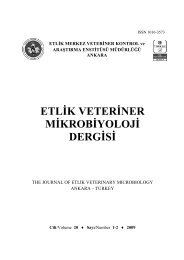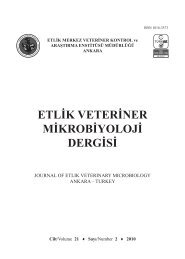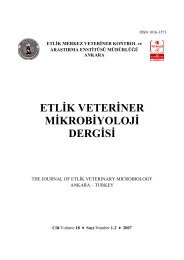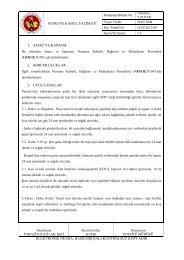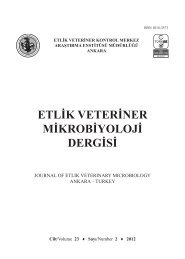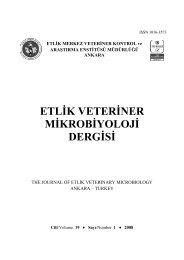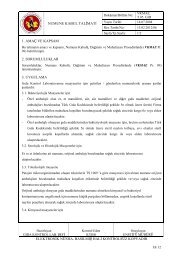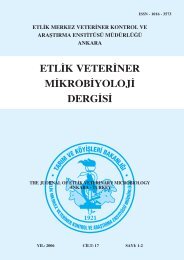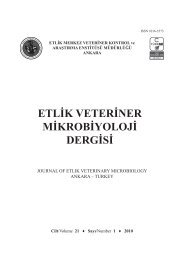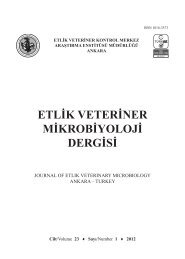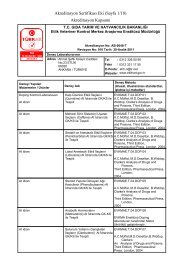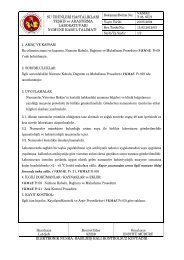etlik veteriner mikrobiyoloji dergisi - veteriner kontrol merkez ...
etlik veteriner mikrobiyoloji dergisi - veteriner kontrol merkez ...
etlik veteriner mikrobiyoloji dergisi - veteriner kontrol merkez ...
You also want an ePaper? Increase the reach of your titles
YUMPU automatically turns print PDFs into web optimized ePapers that Google loves.
Sırıken B ve ark. Etlik Vet Mikrobiyol Derg, 22, 54-60, 2011 59<br />
to 8% in Italy after the avoparcin ban. Lemcke and<br />
Bülte (27), have reported the percentage of vanA-<br />
VRE isolates from poultry in Germany, Netherlands<br />
and France as 14%, 13% and 9%, respectively. Lauderdale<br />
et al. (25), have isolated 39 VRE from 28 of<br />
30 chicken carcasses in Taiwan. In Turkey, VRE has<br />
been found 13-14% by Çelik (7), in various animal<br />
sources. In the results of another study performed in<br />
2005, the isolation percent of VRE from poultry has<br />
been reported as 0.25% (34). Kasimoglu-Dogru et<br />
al. (19), have reported that no Enterococcus isolates<br />
from Ankara province in Turkey detected as VRE<br />
phenotypically and vanA and vanB genes could not<br />
be found in any of these isolates. Similarly, in this<br />
study, no VRE was found among the isolates from<br />
chicken carcasses and meat samples by multiplex-<br />
PCR. This case may associated with the effects of<br />
avoparcin (and/or other feed additives) ban. Although<br />
the studies have showed that the termination<br />
of AGP use resulted in dramatic reduction in occurrence<br />
of VRE in food animals, it has been reported<br />
that these reductions have not led to disappearance<br />
of the strains completely and the resistant strains<br />
might be still present in the farm environment, food<br />
animals and even in the foodstuffs in low level (37).<br />
Thus, although the results of this study in Turkey<br />
show the absence of VRE in chicken carcasses, it<br />
should not be considered that VRE are not appeared<br />
or isolated from various poultry sources anymore.<br />
Slime production and biofilm formation also<br />
determined in both E.fecalis and E.faecium which<br />
are the most common enterococci species have been<br />
suggested as virulence determinants of clinical isolates<br />
(12). Slime factor plays an important role for<br />
adhesion and colonization of organ surfaces or foodcontact<br />
surfaces. If the microorganisms from foodcontact<br />
surfaces are not completely removed, they<br />
may lead to biofilm formation and also increase the<br />
biotransfer potential. Also, biofilm formation may<br />
lead to food spoilage, contamination and significant<br />
economic losses. For these reason, biofilms are an<br />
important reservoir of microbial contamination. In<br />
addition, if the biofilm bacteria are pathogens, then<br />
biofilms pose a serious public health risk (24). It has<br />
been reported that enterococci in biofilms are more<br />
resistant to antibiotics than planktonically growing<br />
enterococci. Therefore, this factor has a great importance<br />
for food industry as well as clinical importance.<br />
Çiftci et al. (8), have reported that 60% of Enterococcus<br />
strains were found as slime positive and<br />
13.43% vancomycin resistant enterococci were<br />
obtained from chicken artritis. They also reported<br />
that slime factor productions of enterococci were<br />
found as 59.7%. In another study (13), the production<br />
of biofilm (slime) has been observed mainly in<br />
E.faecalis isolates from various clinical sources but<br />
only non-numerous strains has formed strong biofilm.<br />
However, Gomes et al. (18), have reported that<br />
none of the different food isolates presented moderate<br />
or strong ability to form biofilm on abiotic surfaces.<br />
Similarly, in this study, none of the enterococci<br />
isolated from chicken carcasses and meat samples<br />
had not ability to form biofilm.<br />
In conclusion, for the moment, Enterococci isolated<br />
in this study in Samsun province do not constitute<br />
a potential risk for the concern of vancomycin<br />
resistant enterococcal infections in humans. Similarly,<br />
the slime factor in enterococci isolated from<br />
chicken carcasses and meat samples in this study<br />
do not pose a hazard for the public health and food<br />
industry including poultry slaughterhouse. However,<br />
because the completely eliminating of VRE<br />
among farm animals including animal origin foods<br />
needs for a long time, chicken materials should be<br />
screened regularly for especially E.faecalis and<br />
E.faecium which may have a potential vancomycin<br />
resistance risk.<br />
References<br />
1. Anonym, T.C. Ministry of Agriculture and Rural Affairs, published<br />
in the official gazette date: 9.07.1999/14428.<br />
2. Bager F, Madsen M, Christensen J, Aarestrup FM, (1997).<br />
Avoparcin used as a growth promoter is associated with the<br />
occurrence of vancomycin-resistant Enterococcus faecium on<br />
Danish poultry and pig farms. Prev Vet Med. 31, 95-112.<br />
3. Bager F, Aarestrup FM, Madsen M, Wegener HC, (1999).<br />
Glycopeptide resistance in Enterococcus faecium from broilers<br />
and pigs following discontinued use of avoparcin. Microb<br />
Drug Resist. 5, 53–56.<br />
4. Bates J, Jordens JZ, Selkon JB, (1993). Evidence for an animal<br />
origin of vancomycin-resistant enterococci (letter). Lancet.<br />
342, 490-1.<br />
5. Bates J, Jordens JZ, Griffiths DT, (1994). Farm animals as a<br />
putative reservoir for vancomycin-resistant enterococcal infection<br />
in man. J Antimicrob Chemoth. 20,191–196.<br />
6. Chingwaru W, Mpuchane SF, Gashe BA, (2003). Enterococcus<br />
faecalis and Enterococcus faecium isolates from milk,<br />
beef, and chicken and their antibiotic resistance. J Food Protect.<br />
66, 931–936.



